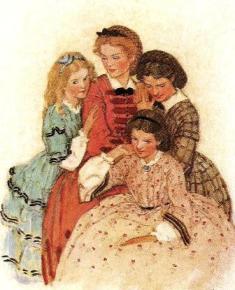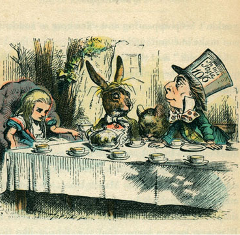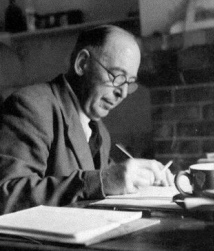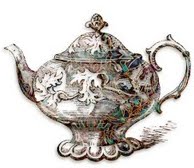Our Pickwick, always at his post…
...inspired by Dickens' “Pickwick Papers.”
This blog is dedicated mostly to the posting of essays, stories and musings, in order for me to improve my skills as a writer.
 Are people born wicked? Or do they have wickedness thrust upon them? Mary Shelley’s Frankenstein goes on to pursue this philosophical question regarding the nature of man. The story recounts the gruesome events in the life of Dr. Victor Frankenstein. After much studying, Dr. Frankenstein attempts to recreate life by combining the severed parts of corpses. He successfully manages to bring his creation to life but flees because of its hideousness.Throughout the story the creature attempts to prove to himself and his creator, that he is not evil. He chops firewood for a family and saves a young woman from drowning. But despite his heroic attempts, he is rejected because of his ugly face. “No mortal could support the horror of that countenance. A mummy again endued with animation could not be so hideous as that wretch.” The creature is continually persecuted by men. This causes him to hate all of mankind. Frankenstein’s creation started out as a “good” thing, innocent of evil, but because of society’s rejection of his appearance; he became a monster.Years later after the publication of Frankenstein another novel was published striving to answer the same question of the nature of man. The Strange Case of Dr. Jekyll and Mr. Hyde by Robert Louis Stevenson is the story about a scientist who is able to create a potion that brings out the evil side of his nature. “Hence although I had now two characters as well as two appearances, one was wholly evil and the other was still the old Henry Jekyll.” The story shows the struggle between Dr. Jekyll and his evil self Mr. Hyde. The doctor ends up being unable to escape Hyde and eventually commits suicide.Unlike the monster describe by Mary Shelley, Mr. Hyde is the alternate side of Dr. Jekyll. The doctor is a highly respected man and Hyde is feared by society. Although these characters are two different men in appearances, they are one in the same; one being altogether good and the other altogether evil. “Man is not truly one, but truly two.” Is the creature of Frankenstein and Mr. Hyde so very different? They are both ugly in countenance and feared by society. They are murderers and creatures created by scientists. These two characters are both described in physical appearances that correspond with their morality. But the morality defined through these characters goes on to portray two very different concepts about man’s inner nature.The philosophy presented in Frankenstein allows man to blame others for his evil behavior. But Robert Louis Stevenson defined man’s morality by attributing it to his own nature. Frankenstein’s monster is evil by circumstance, while Dr. Jekyll’s monster is evil by nature. Mary Shelley and Robert Louis Stevenson attempted to describe evil both in physical descriptions and metaphorical examples. But Mary Shelley looked only on the surface of man and failed to see the monster within.Writers as well as scientists and philosophers have striven to explain the nature of man. But it always comes down to two conclusions. Evil is either an impact from the world or an issue from within. Man is either a monster like that of Frankenstein or Mr. Hyde.
Are people born wicked? Or do they have wickedness thrust upon them? Mary Shelley’s Frankenstein goes on to pursue this philosophical question regarding the nature of man. The story recounts the gruesome events in the life of Dr. Victor Frankenstein. After much studying, Dr. Frankenstein attempts to recreate life by combining the severed parts of corpses. He successfully manages to bring his creation to life but flees because of its hideousness.Throughout the story the creature attempts to prove to himself and his creator, that he is not evil. He chops firewood for a family and saves a young woman from drowning. But despite his heroic attempts, he is rejected because of his ugly face. “No mortal could support the horror of that countenance. A mummy again endued with animation could not be so hideous as that wretch.” The creature is continually persecuted by men. This causes him to hate all of mankind. Frankenstein’s creation started out as a “good” thing, innocent of evil, but because of society’s rejection of his appearance; he became a monster.Years later after the publication of Frankenstein another novel was published striving to answer the same question of the nature of man. The Strange Case of Dr. Jekyll and Mr. Hyde by Robert Louis Stevenson is the story about a scientist who is able to create a potion that brings out the evil side of his nature. “Hence although I had now two characters as well as two appearances, one was wholly evil and the other was still the old Henry Jekyll.” The story shows the struggle between Dr. Jekyll and his evil self Mr. Hyde. The doctor ends up being unable to escape Hyde and eventually commits suicide.Unlike the monster describe by Mary Shelley, Mr. Hyde is the alternate side of Dr. Jekyll. The doctor is a highly respected man and Hyde is feared by society. Although these characters are two different men in appearances, they are one in the same; one being altogether good and the other altogether evil. “Man is not truly one, but truly two.” Is the creature of Frankenstein and Mr. Hyde so very different? They are both ugly in countenance and feared by society. They are murderers and creatures created by scientists. These two characters are both described in physical appearances that correspond with their morality. But the morality defined through these characters goes on to portray two very different concepts about man’s inner nature.The philosophy presented in Frankenstein allows man to blame others for his evil behavior. But Robert Louis Stevenson defined man’s morality by attributing it to his own nature. Frankenstein’s monster is evil by circumstance, while Dr. Jekyll’s monster is evil by nature. Mary Shelley and Robert Louis Stevenson attempted to describe evil both in physical descriptions and metaphorical examples. But Mary Shelley looked only on the surface of man and failed to see the monster within.Writers as well as scientists and philosophers have striven to explain the nature of man. But it always comes down to two conclusions. Evil is either an impact from the world or an issue from within. Man is either a monster like that of Frankenstein or Mr. Hyde.
 The phenomenon of Twilight has left fans everywhere “vampire crazed”. The morbid yet romantic tale of a vampire restraining his monster-like instincts in attempts to become more human, has captured the hearts of many young girls around the world. But before Stephenie Meyer’s novels became popular, another New York Times Best-Seller called The Vampire Diaries had topped the boards nearly 14 years before. Today it’s the CW’s newest drama based on the series written by L.J Smith.Paul Wesley (who plays Stefan the vampire) comments that although the show is being criticized as a Twilight spin-off, the two are not as similar as you would think. "They have vampires and high school romance in common, but that's about it."That being said, the books do have similar plots but the characters are slightly different. In Twilight Bella is just an average girl. In The Vampire Diaries Elena is one of the most popular girls in school. Both girls have crushes on a vampire. Stefan and Edward (the vampire dudes) do not drink human blood.Stephenie Meyers admitted that she never read The Vampire Diaries while writing Twilight. So it is obvious that neither of the authors intended to copy one another. I think it is safe to say that the similarities are just a coincidence.And as if we didn’t have enough vampire stories in the world already, another series has come to the screen in the new movie The Vampire’s Assistant in theaters October 23.
The phenomenon of Twilight has left fans everywhere “vampire crazed”. The morbid yet romantic tale of a vampire restraining his monster-like instincts in attempts to become more human, has captured the hearts of many young girls around the world. But before Stephenie Meyer’s novels became popular, another New York Times Best-Seller called The Vampire Diaries had topped the boards nearly 14 years before. Today it’s the CW’s newest drama based on the series written by L.J Smith.Paul Wesley (who plays Stefan the vampire) comments that although the show is being criticized as a Twilight spin-off, the two are not as similar as you would think. "They have vampires and high school romance in common, but that's about it."That being said, the books do have similar plots but the characters are slightly different. In Twilight Bella is just an average girl. In The Vampire Diaries Elena is one of the most popular girls in school. Both girls have crushes on a vampire. Stefan and Edward (the vampire dudes) do not drink human blood.Stephenie Meyers admitted that she never read The Vampire Diaries while writing Twilight. So it is obvious that neither of the authors intended to copy one another. I think it is safe to say that the similarities are just a coincidence.And as if we didn’t have enough vampire stories in the world already, another series has come to the screen in the new movie The Vampire’s Assistant in theaters October 23. “The Vampire's Assistant tells the frightening tale of a boy who unknowingly breaks a 200-year-old truce between two warring factions of vampires. Pulled into a fantastic life of misunderstood sideshow freaks and grotesque creatures of the night, one teen will vanish from the safety of a boring existence and fulfill his destiny in a place drawn from nightmares.”
“The Vampire's Assistant tells the frightening tale of a boy who unknowingly breaks a 200-year-old truce between two warring factions of vampires. Pulled into a fantastic life of misunderstood sideshow freaks and grotesque creatures of the night, one teen will vanish from the safety of a boring existence and fulfill his destiny in a place drawn from nightmares.”
--© UniversalWhich one is better? Read the books, watch the movies, watch the TV show, and vote for your favorites…
It was nineteen degrees outside as she got into the defrosting car. The air was so cold she could see her breath coming out in little white puffs of air. She coughed into her cold hands and sighed sadly. A severe chest cold took hold of her the week before and she was still recovering. But she felt confident enough to still go through with the test. She entered the school doors; arms overflowing with the necessary equipment:
Two No. 2 pencils…check!Scientific calculator…check!Admission ticket…check!The classroom was filled with nearly fifty other students from various schools around the county. They spoke loudly with one another. The girls hugged each other and laughed together; their cares seemingly far away. Finally the time had come. The students were ushered into a small library. When they took their seats they glanced down at the daunting test booklets laid out before them. The once happy faces were now stricken with fear.The proctor (who was in her late sixties) made it apparent almost as soon as the students entered the room that she did NOT like teenagers. Her voice, shrill and witch-like, pierced through the noisy chatter: “No talking!” A hush fell over the room almost instantly. She explained the test rules as if speaking to juvenile delinquents. A few of the cockier students chuckled at her demeanor but the rest folded their hands on their desks like good little children.The timer was set and the testing began! Three hours had been laid aside to quiz the students with confusing multiple questions and impossible math equations.The Reading Comprehension was helpful with its overly vague questions like this one:In Lines 17-39 (depicting…humbling), did the author mean:a) obnoxiousb) he wanted to eat ice creamc) his mother and father didn’t approve of his relationship with herd) the title of this section should be…Other sections were just as puzzling. They had five minute breaks every two sections. Their proctor shouted at them during the breaks reminding them of ridiculous rules: “Don’t talk with each other! No water bottles in the testing room! Your scores will be canceled if you have any answers written inside any food wrappers or bottle labels!” Bathroom breaks were extremely short and "taking a breather" was nearly unacceptable. But soon they all returned to their seats and began testing once more.“You have five minutes!” shouted the proctor. She startled some of the students out of their chairs. Three hours seemed more like days but now there was just five more minutes. The old crone paraded around their tables watching their every move. Suddenly her stopwatch beeped softly. It could barely be heard at first. The students raised their heads and looked at their jailer through bloodshot eyes. She gave them a curt nod of the head, announcing wordlessly that it was all over. The students gathered up their pencils and calculators and nearly ran outside the classroom; they were so relieved. No more studying, no more practice tests, no more filling in the circles on the answer sheets; the test was over and they were free!The girl from the beginning of our story finished her test on time. She coughed only once during the test. Her nose had stopped running and she was actually feeling better. Her head however, was swimming with evaluations and although she couldn’t see straight, a sudden calm overtook her. Whether or not her scores were good or bad she had done her best. And knowing that made her feel just fine.
 It being one of the principles of the Circumlocution Office never, on any account whatever, to give a straightforward answer, Mr Barnacle said, 'Possibly.'
It being one of the principles of the Circumlocution Office never, on any account whatever, to give a straightforward answer, Mr Barnacle said, 'Possibly.'
Little Dorrit ~Charles Dickens
 Are people born wicked? Or do they have wickedness thrust upon them? Mary Shelley’s Frankenstein goes on to pursue this philosophical question regarding the nature of man. The story recounts the gruesome events in the life of Dr. Victor Frankenstein. After much studying, Dr. Frankenstein attempts to recreate life by combining the severed parts of corpses. He successfully manages to bring his creation to life but flees because of its hideousness.
Are people born wicked? Or do they have wickedness thrust upon them? Mary Shelley’s Frankenstein goes on to pursue this philosophical question regarding the nature of man. The story recounts the gruesome events in the life of Dr. Victor Frankenstein. After much studying, Dr. Frankenstein attempts to recreate life by combining the severed parts of corpses. He successfully manages to bring his creation to life but flees because of its hideousness.





+of+Little+Women2.jpg)
.png)
.png)


.png)







.png)



